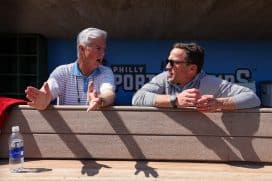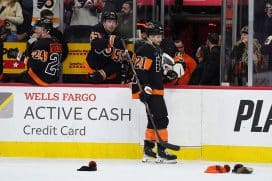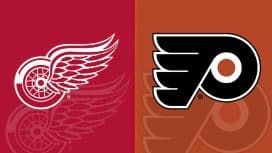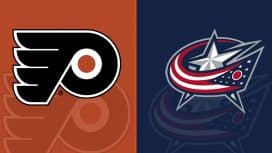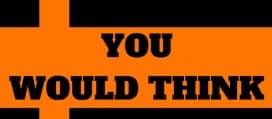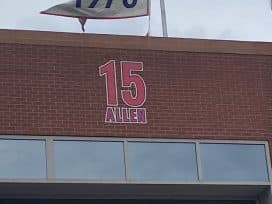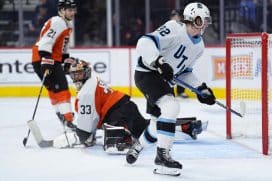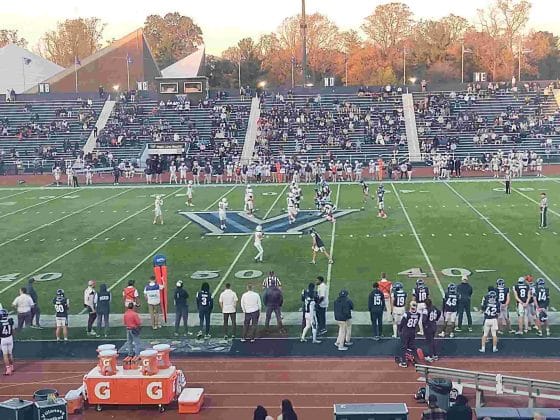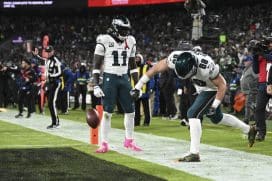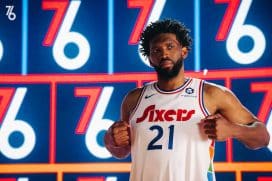Sixers
NBA Draft Preview: Guards/Forwards the 76ers Could Target
By Matt Gregan, Sports Talk Philly Staff
The NBA Draft, which marks the beginning of the NBA's exciting offseason, takes place on Thursday night at 7 in the Barclays Center in New York City.
The Philadelphia 76ers, who hold pick No. 24 in the first round and pick Nos. 33, 34, 42 and 54 in the second round, are presented with a golden opportunity to add some much needed depth to its roster. With this year's massive free agency period and Ben Simmons' presumed upcoming contract extension looming in the Sixers' near future, general manager Elton Brand will have to make sure he takes advantage of his opportunities to add cheap talent to the roster.
Throughout the week leading up to the NBA Draft, we will look at prospects that the Sixers could be interested in taking with their first-round pick at No. 24 overall. Today's edition will examine some of the guards/forwards that the team should consider using their first-round pick on.
Matisse Thybulle
Thybulle, a 6-foot-5 guard/forward from Washington, was a defensive standout throughout his four years with the Huskies. He excels at using his elite athleticism and length (7-foot wingspan) to disrupt opposing offenses. As a senior, he averaged 2.3 blocks and 3.5 steals per game while leading Washington's defense, which ranked 30th in NCAA Division I men's basketball in points given up per game (64.8).
The Washington native doesn't excel on the offensive end, averaging only 9.3 points per game throughout his collegiate career with the Huskies. However, Thybulle is a 36 percent career 3-point shooter, which is good enough to not offset the tremendous defensive impact that he puts on games. He does not profile as a player who will be known for his offensive abilities, but his lockdown defense combined with being an average 3-point shooter should result in becoming a solid NBA role player.
Thybulle, due to his ability to impact the game defensively as a wing, should be considered by the 76ers at pick No. 24. However, he does not help to improve on two of the team's biggest needs, bench scoring and a backup big man to play behind Joel Embiid. His defensive abilities are certainly intriguing, but the Sixers could easily get turned away by his lack of skills on the offensive end.
"All things considered, he's a low-risk, high-reward option in this range of the draft [late first round]," Jeremy Woo wrote in Sports Illustrated's 2019 NBA Draft Big Board.
Ty Jerome
Jerome is a savvy scorer who consistently showed the ability to be a playmaker for the Virginia Cavaliers, leading them to winning this year's national championship. The 6-foot-5 guard, throughout his three years in Virginia, continually developed his abilities as a passer, increasing his assists from 3.9 to 5.5 per game from his sophomore to junior years.
In addition to his abilities as a playmaker, Jerome can also shoot the ball well from 3-point range. He was a career 39.2 percent 3-point shooter, averaging four attempts per game. He is a finesse scorer who possesses the ability to play well out of the pick-and-roll. Jerome was one of the best pick-and-roll players in college basketball last season, mostly due to his ability to shoot combined with his vision as a passer.
Jerome also possesses the intangibles that allow him to compete on the defensive end of the floor despite his tweener size (6-foot-5). He has the size to play both guard positions when needed, although he can get bullied by some bigger NBA shooting guards. However, he plays hard and he possesses a great floor vision, both of which help allow him to overcome whatever weaknesses his lack of size would present.
"He’s a steady decision-maker who excels creating good looks for himself and others in pressure situations, and could be a plug-and-play backcourt piece early in his career," Jeremy Woo wrote in Sports Illustrated's 2019 NBA Draft Big Board.
The New York native also showed that he can step up in big, high-pressure situations. He averaged 18.5 points, 6.8 assists and 6.5 rebounds per game beginning in the Sweet 16 of this year's NCAA Tournament.
Jerome would fit well as a member of the Sixers, perhaps being able to fill some of the void left by the trade of Landry Shamet and the potential loss of J.J. Redick in free agency this season. He has been projected to go anywhere in the 20s in the first round on Thursday night.
Cameron Johnson
Johnson's draft stock rose greatly after a senior season at North Carolina in which he became one of college's best outside shooters. He became one of the Tar Heels' best players, averaging 16.9 points and 5.8 rebounds while shooting 45.7 percent from 3-point range.
Standing at 6-foot-8, many would think that Johnson would be able to play at either forward position. However, he lacks many of the skills and physical traits to be able to play at the power forward position at the NBA level. He is only 205 pounds and was often out-rebounded by more physical forwards. His defense can also use some improvement, although he does have the speed and length to be able to be a decent defender in space against smaller NBA forwards.
Other concerns about Johnson include his lack of a complete offensive game. He is not a good finisher at the rim and can be easily knocked out of his spot while driving to the basket. He also shot only 34.1 percent from 3-point range as a junior at North Carolina, giving concerns that his great outside shooting could potentially have been a one-year wonder.
However, at the worst, Johnson should be a player who can specialize in outside shooting. He will not reach his potential until he gets stronger and more physical, which would allow him to both become a better rebounder and defender as well as improving on his career 3.2 free throw attempts per game.
Johnson would be a good fit for the Sixers, a team that needs more perimeter shooting. He profiles as a role player who should immediately be able to come in and provide a spark off the bench.
Carsen Edwards
Edwards, a 6-foot 199 pound guard from Purdue, would be a good fit on the 76ers. He can score from anywhere on the court, has shown that he can be clutch in big situations and has a bulldog mentality to pair with his aggressive style on the court.
Edwards averaged 24.3 points as a junior at Purdue while leading them into the NCAA Tournament. While there, he went off and carried the Boilermakers into the Elite 8, losing to the eventual national champion Virginia. He averaged 34.8 points per game in the Tournament.
The Texas native excels at scoring from anywhere on the court, but that's not the only thing he can do. He has an ability to spread the ball to his teammates, although he has a clear preference to shoot the ball rather than pass. He averaged 2.5 assists per game in his college career.
What has caused Edwards' stock to fall in the draft has been that he is undersized, even for a guard. At 6-foot, Edwards will have some struggles guarding bigger NBA guards. However, his physical, aggressive style on the court will help him somewhat overcome his lack of size.
Edwards has never been an efficient shooter during his time at Purdue. He shot 41.2 percent from the field and 36.8 percent from 3-point range in his three years at Purdue. His efficiency is one thing that he will definitely have to work on if he comes to the 76ers, because he will not the one of the team's top scoring options and therefore will not have the ability to be a volume shooter.
As NBC Sports Philadelphia's Paul Hudrick exceptionally pointed out in his article on Edwards leading up to the draft, it will be an adjustment for him to learn how to fit in as one of the secondary options if he gets drafted by the 76ers. However, it is an adjustment that he has successfully gone through at every level from high school to college, and that gives fans hope that he will once again be able to successfully adjust to his new role.
Edwards, if drafted by the 76ers, would fit in primarily as a shooting guard who also is capable of running the offense either when Ben Simmons is off the floor or is trying to post up. The Ringer's Kevin O'Connor writes in their mock draft that Edwards profiles as a classic scoring sixth man, the likes that the team has not had since Lou Williams.
Dylan Windler
Windler, a 6-foot-7 196 pound forward from Belmont, has 3-and-D potential written all over him. Throughout his four years playing at Belmont, he has continuously developed his game, eventually leading him to average a double-double his senior year. He is an efficient scorer who specializes in being able to shoot from 3-point range.
Over his last two years at Belmont, Windler has shot 42.8 percent from 3-point range, effectively showing that he can shoot consistently and efficiently from outside the arc. He showed during his senior season, one in which he led the Bruins to the NCAA Tournament, that he can continue to be efficient even while stepping up to be the team's main option. His efficiency did not take a dip despite the increase in shot attempts between his junior and senior seasons (11.1 to 13.6 field goal attempts per game, 4.9 to 7.1 3-point attempts per game).
At the collegiate level, Windler was able to be a good rebounder and an average defender, grabbing 10.8 rebounds per game his senior season. However, he will need to work to fill out his frame and add muscle in order to continue to be a good rebounder at the NBA level.
Many of the concerns that NBA scouts have are regarding his smaller frame. He has struggled at times on the defensive end against stronger, more physical forwards. Also, he is not very athletic and as a result has gotten beat on the defensive end by quicker forwards.
However, Windler's shooting will keep him higher up as an option for teams drafting late in the first round. Windler would be a great fit with the 76ers, who are looking for some more shooting off the bench. Windler, even if never develops the rest of his game and becomes a better defender, should always be able to be a good shooter from outside, something that the Sixers are in desperate need of.
